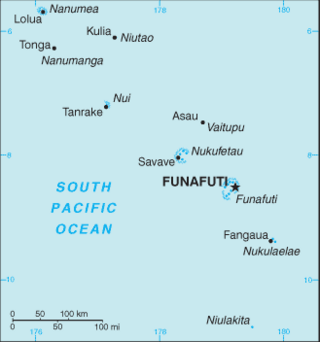
The Western Pacific nation of Tuvalu, formerly known as the Ellice Islands, is situated 4,000 kilometers (2,500 mi) northeast of Australia and is approximately halfway between Hawaii and Australia. It lies east-northeast of the Santa Cruz Islands, southeast of Nauru, south of Kiribati, west of Tokelau, northwest of Samoa and Wallis and Futuna and north of Fiji. It is a very small island country of 26 km2 (10 sq mi). Due to the spread out islands it has the 38th largest Exclusive Economic Zone of 749,790 km2 (289,500 sq mi). In terms of size, it is the second-smallest country in Oceania.
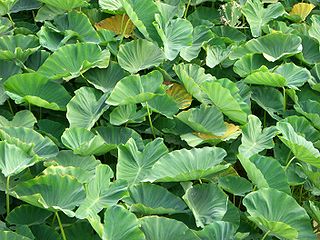
Colocasia is a genus of flowering plants in the family Araceae, native to southeastern Asia and the Indian subcontinent. Some species are widely cultivated and naturalized in other tropical and subtropical regions.

The cuisine of Hawaii incorporates five distinct styles of food, reflecting the diverse food history of settlement and immigration in the Hawaiian Islands.[a]

Taro is a root vegetable. It is the most widely cultivated species of several plants in the family Araceae that are used as vegetables for their corms, leaves, stems and petioles. Taro corms are a food staple in African, Oceanic, East Asian, Southeast Asian and South Asian cultures. Taro is believed to be one of the earliest cultivated plants.

Kūlolo is a Hawaiian dish made with taro and coconut. Considered a pudding, kūlolo has a chewy and solid consistency like fudge or Southeast Asian dodol, with a flavor similar to caramel or Chinese nian gao. Because taro is widely cultivated on the island of Kauai, taro products such as kūlolo is often associated with the island. It is a well-beloved dish well documented by many non-Hawaiians since the late 1800s, sometimes found during festive occasions like at lūʻau.

Tacca leontopetaloides is a species of flowering plant in the yam family Dioscoreaceae. It is native to the islands of Southeast Asia. Austronesian peoples introduced it as a canoe plant throughout the Indo-Pacific tropics during prehistoric times. It has become naturalized to tropical Africa, South Asia, northern Australia, and Oceania. Common names include Polynesian arrowroot, Fiji arrowroot, East Indies arrowroot, pia, and seashore bat lily.
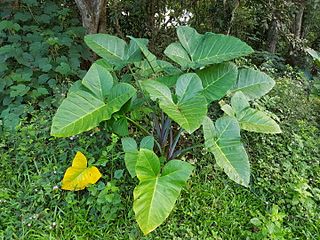
Xanthosoma sagittifolium(Tannia) is a tropical flowering plant from the family Araceae. It produces an edible, starchy corm. X. sagittifolium is native to tropical America where it has been first cultivated. Around the 19th century, the plant spread to Southeast Asia and Africa and has been cultivated there ever since. X. sagittifolium is often confused with the related plant Colocasia esculenta (Taro), which looks very similar and is also used in a similar way. Both plants are often collectively named Cocoyam.

Laing, is a Filipino dish of shredded or whole taro leaves with meat or seafood cooked in thick coconut milk spiced with labuyo chili, lemongrass, garlic, shallots, ginger, and shrimp paste. It originates from the Bicol Region, where it is known simply as pinangat. Laing is also a type of ginataan, and thus may also be referred to as ginataang laing. Laing is commonly eaten as a vegetable side to complement meat or fish side dishes known as ulam in Filipino, which is normally paired with boiled white rice.

The cuisine of Vanuatu incorporates fish, root vegetables such as taro and yams, fruits, and vegetables. Most island families grow food in their gardens, and food shortages are rare. Papayas, pineapples, mangoes, plantains, and sweet potatoes are abundant through much of the year. Coconut milk and cream are used to flavour many dishes. Most food is cooked using hot stones or through boiling and steaming; little food is fried. Since Vanuatu is one of the few South Pacific regions influenced by the outside world, Vanuatu's food has a multicultural nature.

Fijian cuisine has long consisted of primarily foraged and farm-grown food. Although rice, wheat, and tea all became staples during Fiji's colonial era, native Fijians still eat primarily tubers and coconuts. The cuisine of Fiji is known for its seafood and various green vegetables, including ''ota'', a young forest fern, and ''bele'', a plant that resembles spinach.

Binignit is a Visayan dessert soup from the central Philippines. The dish is traditionally made with glutinous rice cooked in coconut milk with various slices of sabá bananas, taro, ube, and sweet potato, among other ingredients. It is comparable to various dessert guinataán dishes found in other regions such as bilo-bilo. Among the Visayan people, the dish is traditionally served during Good Friday of Holy Week.

A great variety of cassava-based dishes are consumed in the regions where cassava is cultivated.

Cyrtosperma merkusii or giant swamp taro, is a crop grown throughout Oceania and into South and Southeast Asia. It is a riverine and "swamp crop" similar to taro, but "with bigger leaves and larger, coarser roots." There are no demonstrably wild populations today, but it is believed to be native to Indonesia. It is known as puraka in Cook Islands, lak in Yap, babai in Kiribati, iaraj in the Marshall Islands, brak in Palau, babaʻ in the Marianas Islands, pula’a in Samoa, via kana, Pulaka in Lau, Lovo in Fiji, pulaka in Tokelau and Tuvalu, mwahng in Pohnpei, pasruk in Kosrae, simiden in Chuuk, swam taro in Papua New Guinea, navia in Vanuatu and palawan in the Philippines.
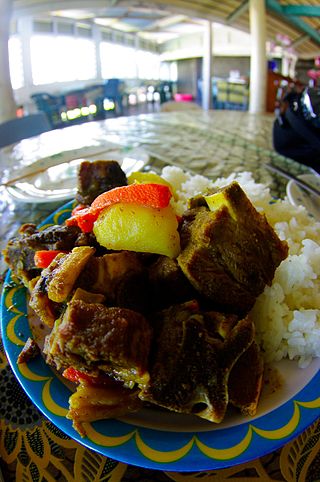
The cuisine of Tuvalu, a state in the Central Pacific (Oceania), is based on the staple of coconut and the many species of fish found in the ocean and the lagoons of the atolls of Tuvalu. Pulaka,, or swamp taro, is an important source of carbohydrates. Rice now forms an important part of the diet. Coconut is used in different forms with coconut water, coconut milk and the flesh of the coconut being used to flavour dishes. Various desserts made on the islands include coconut and coconut milk, instead of animal milk.

Niue is an island in the Southern Pacific, mostly inhabited by Polynesians. The plantations are mostly filled with manioc, taro and breadfruit, but banana trees can be found. The wide range of exotic plants in Niue includes taros, pawpaw, coconuts, bananas, yams, cassavas and breadfruits: All are intensively used in the local cuisine.
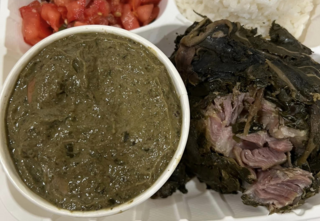
Lūʻau, Luʻau, Laulau, Lū, Rourou, Rukau, Fāfā, Hāhā, and Palusami are all related dishes found throughout Polynesia based on the use of taro leaves as a primary ingredient. While taro generally is known as a root vegetable for its starchy corms, the leaves are consumed as well. The base recipe is vegetarian. Most often, coconut milk was added, and later meat or seafood. The texture of the dish range from a thick soup to a dense cake.
Agriculture in Tuvalu is based on coconut and swamp taro, , which is similar to taro but "with bigger leaves and larger, coarser roots"; taro is also cultivated in Tuvalu.

Native Hawaiian cuisine refers to the traditional Hawaiian foods that predate contact with Europeans and immigration from East and Southeast Asia. The cuisine consisted of a mix of indigenous plants and animals as well as plants and animals introduced by Polynesian voyagers, who became the Native Hawaiians.

Ube halaya or halayang ube is a Philippine dessert made from boiled and mashed purple yam. Ube halaya is the main base in ube/purple yam flavored-pastries and ube ice cream. It can also be incorporated in other desserts such as halo-halo. It is also commonly anglicized as ube jam, or called by its original native name, nilupak na ube.

The cuisine of Papua New Guinea are the traditional varied foods found in the eastern part of the New Guinea island. Approximately 80% of the population is reliant on subsistence agriculture, so a large percentage of food energy and protein consumed in Papua New Guinea is produced locally, while the balance is imported. The staple foods in Papua New Guinea includes root crops, bananas, and sago. Papua New Guinea's diet is largely vegetarian, especially in the Gulf and Highlands regions.



















